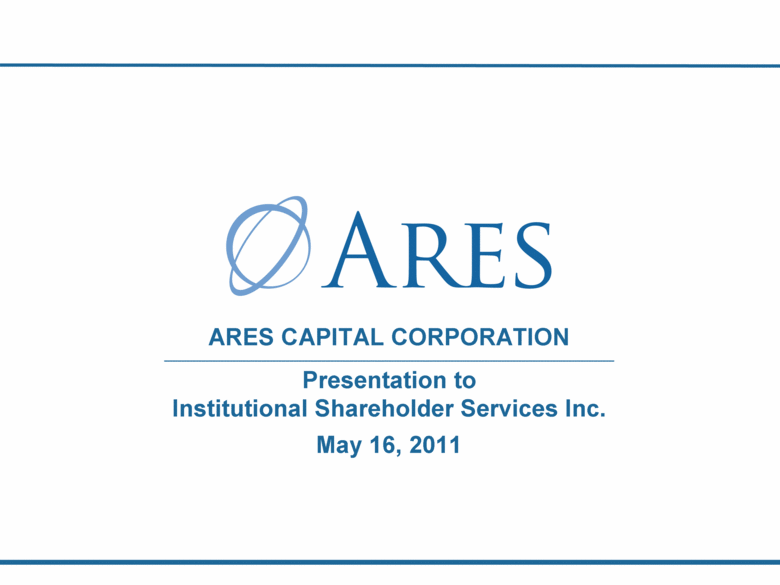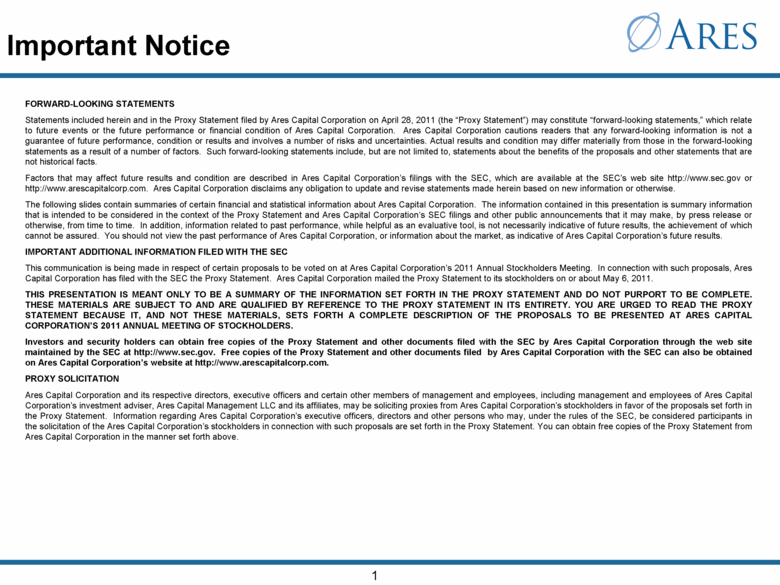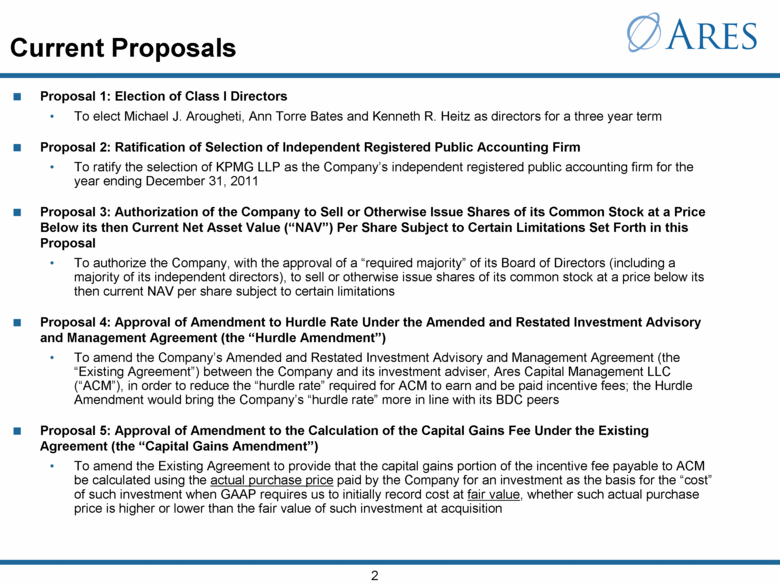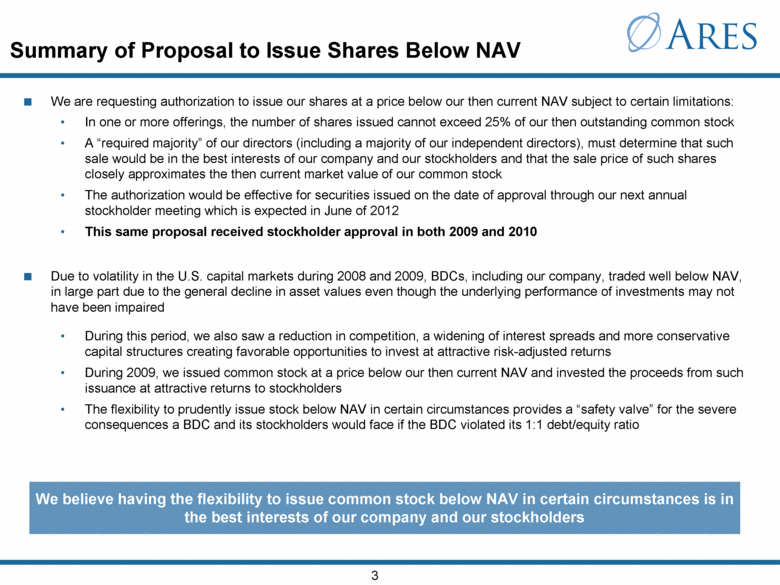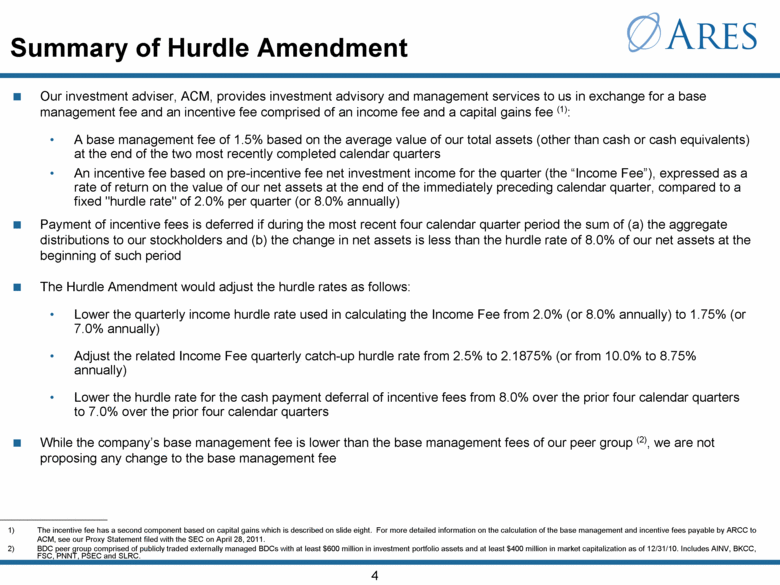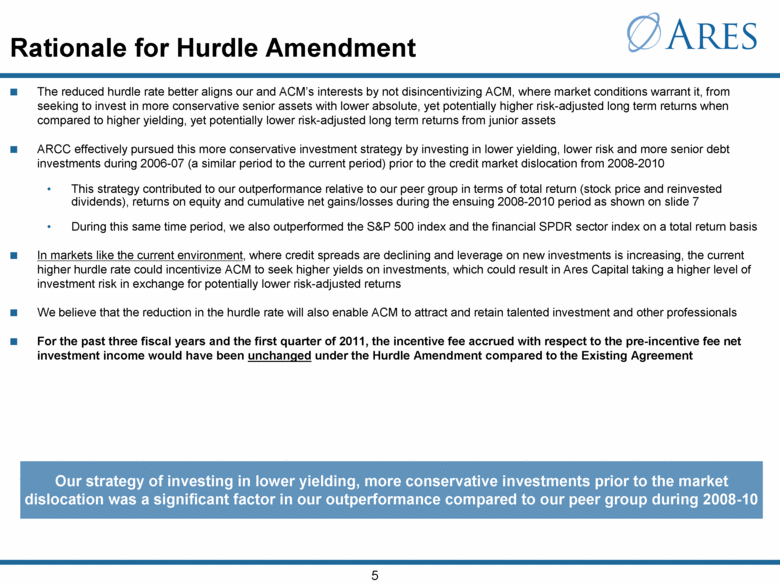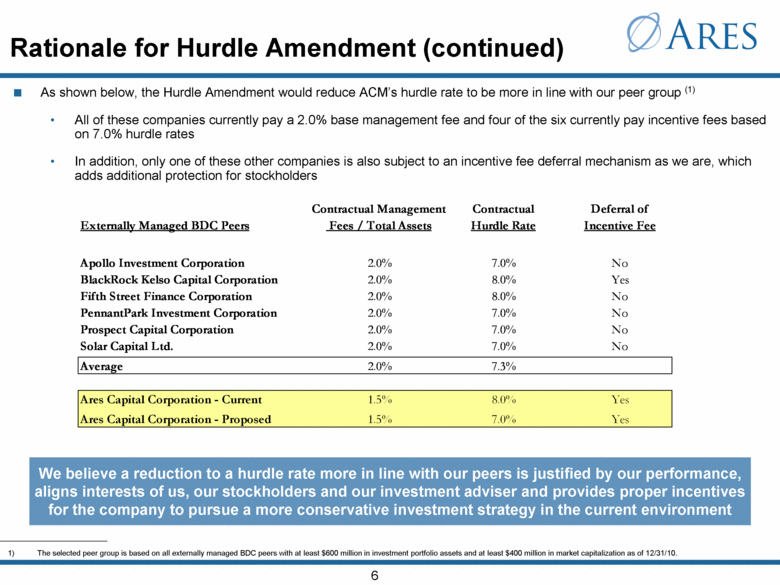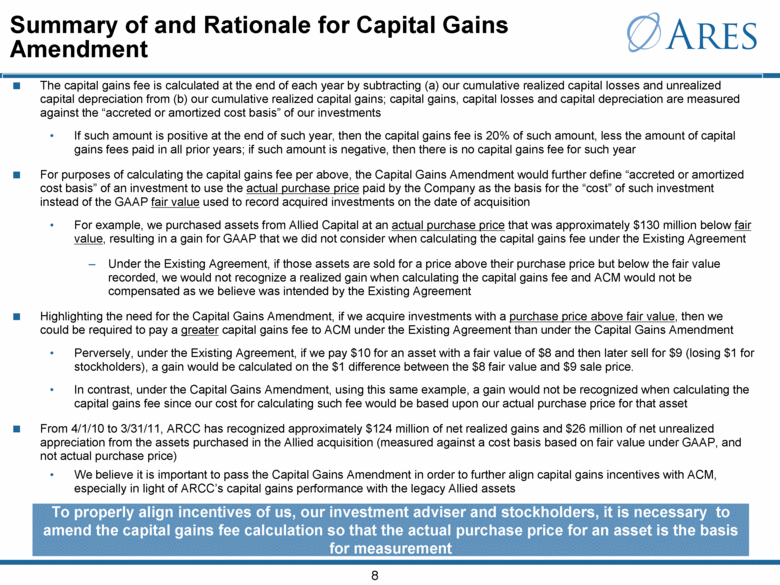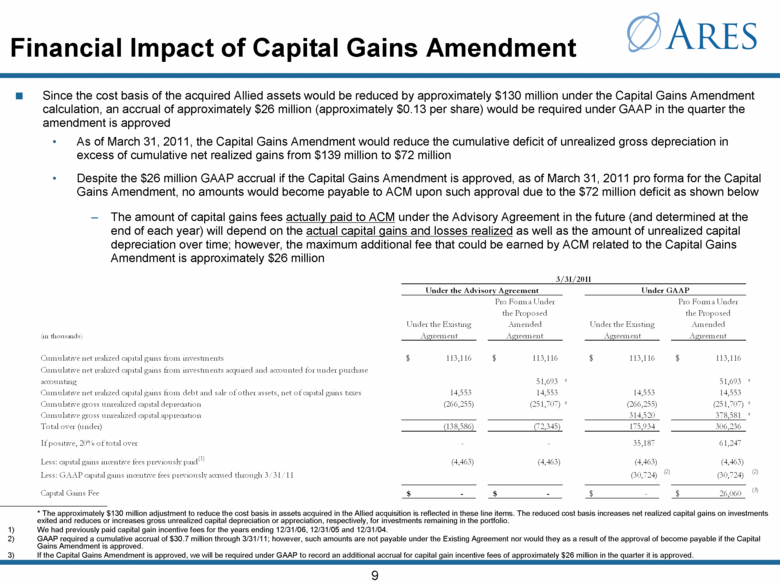Attached files
| file | filename |
|---|---|
| 8-K - 8-K - ARES CAPITAL CORP | a11-12482_18k.htm |
Exhibit 99.1
|
|
May 16, 2011 Presentation to Institutional Shareholder Services Inc. ARES CAPITAL CORPORATION |
|
|
Important Notice FORWARD-LOOKING STATEMENTS Statements included herein and in the Proxy Statement filed by Ares Capital Corporation on April 28, 2011 (the “Proxy Statement”) may constitute “forward-looking statements,” which relate to future events or the future performance or financial condition of Ares Capital Corporation. Ares Capital Corporation cautions readers that any forward-looking information is not a guarantee of future performance, condition or results and involves a number of risks and uncertainties. Actual results and condition may differ materially from those in the forward-looking statements as a result of a number of factors. Such forward-looking statements include, but are not limited to, statements about the benefits of the proposals and other statements that are not historical facts. Factors that may affect future results and condition are described in Ares Capital Corporation’s filings with the SEC, which are available at the SEC’s web site http://www.sec.gov or http://www.arescapitalcorp.com. Ares Capital Corporation disclaims any obligation to update and revise statements made herein based on new information or otherwise. The following slides contain summaries of certain financial and statistical information about Ares Capital Corporation. The information contained in this presentation is summary information that is intended to be considered in the context of the Proxy Statement and Ares Capital Corporation’s SEC filings and other public announcements that it may make, by press release or otherwise, from time to time. In addition, information related to past performance, while helpful as an evaluative tool, is not necessarily indicative of future results, the achievement of which cannot be assured. You should not view the past performance of Ares Capital Corporation, or information about the market, as indicative of Ares Capital Corporation’s future results. IMPORTANT ADDITIONAL INFORMATION FILED WITH THE SEC This communication is being made in respect of certain proposals to be voted on at Ares Capital Corporation’s 2011 Annual Stockholders Meeting. In connection with such proposals, Ares Capital Corporation has filed with the SEC the Proxy Statement. Ares Capital Corporation mailed the Proxy Statement to its stockholders on or about May 6, 2011. THIS PRESENTATION IS MEANT ONLY TO BE A SUMMARY OF THE INFORMATION SET FORTH IN THE PROXY STATEMENT AND DO NOT PURPORT TO BE COMPLETE. THESE MATERIALS ARE SUBJECT TO AND ARE QUALIFIED BY REFERENCE TO THE PROXY STATEMENT IN ITS ENTIRETY. YOU ARE URGED TO READ THE PROXY STATEMENT BECAUSE IT, AND NOT THESE MATERIALS, SETS FORTH A COMPLETE DESCRIPTION OF THE PROPOSALS TO BE PRESENTED AT ARES CAPITAL CORPORATION’S 2011 ANNUAL MEETING OF STOCKHOLDERS. Investors and security holders can obtain free copies of the Proxy Statement and other documents filed with the SEC by Ares Capital Corporation through the web site maintained by the SEC at http://www.sec.gov. Free copies of the Proxy Statement and other documents filed by Ares Capital Corporation with the SEC can also be obtained on Ares Capital Corporation’s website at http://www.arescapitalcorp.com. PROXY SOLICITATION Ares Capital Corporation and its respective directors, executive officers and certain other members of management and employees, including management and employees of Ares Capital Corporation’s investment adviser, Ares Capital Management LLC and its affiliates, may be soliciting proxies from Ares Capital Corporation’s stockholders in favor of the proposals set forth in the Proxy Statement. Information regarding Ares Capital Corporation’s executive officers, directors and other persons who may, under the rules of the SEC, be considered participants in the solicitation of the Ares Capital Corporation’s stockholders in connection with such proposals are set forth in the Proxy Statement. You can obtain free copies of the Proxy Statement from Ares Capital Corporation in the manner set forth above. |
|
|
Current Proposals Proposal 1: Election of Class I Directors To elect Michael J. Arougheti, Ann Torre Bates and Kenneth R. Heitz as directors for a three year term Proposal 2: Ratification of Selection of Independent Registered Public Accounting Firm To ratify the selection of KPMG LLP as the Company’s independent registered public accounting firm for the year ending December 31, 2011 Proposal 3: Authorization of the Company to Sell or Otherwise Issue Shares of its Common Stock at a Price Below its then Current Net Asset Value (“NAV”) Per Share Subject to Certain Limitations Set Forth in this Proposal To authorize the Company, with the approval of a “required majority” of its Board of Directors (including a majority of its independent directors), to sell or otherwise issue shares of its common stock at a price below its then current NAV per share subject to certain limitations Proposal 4: Approval of Amendment to Hurdle Rate Under the Amended and Restated Investment Advisory and Management Agreement (the “Hurdle Amendment”) To amend the Company’s Amended and Restated Investment Advisory and Management Agreement (the “Existing Agreement”) between the Company and its investment adviser, Ares Capital Management LLC (“ACM”), in order to reduce the “hurdle rate” required for ACM to earn and be paid incentive fees; the Hurdle Amendment would bring the Company’s “hurdle rate” more in line with its BDC peers Proposal 5: Approval of Amendment to the Calculation of the Capital Gains Fee Under the Existing Agreement (the “Capital Gains Amendment”) To amend the Existing Agreement to provide that the capital gains portion of the incentive fee payable to ACM be calculated using the actual purchase price paid by the Company for an investment as the basis for the “cost” of such investment when GAAP requires us to initially record cost at fair value, whether such actual purchase price is higher or lower than the fair value of such investment at acquisition |
|
|
Summary of Proposal to Issue Shares Below NAV We are requesting authorization to issue our shares at a price below our then current NAV subject to certain limitations: In one or more offerings, the number of shares issued cannot exceed 25% of our then outstanding common stock A “required majority” of our directors (including a majority of our independent directors), must determine that such sale would be in the best interests of our company and our stockholders and that the sale price of such shares closely approximates the then current market value of our common stock The authorization would be effective for securities issued on the date of approval through our next annual stockholder meeting which is expected in June of 2012 This same proposal received stockholder approval in both 2009 and 2010 Due to volatility in the U.S. capital markets during 2008 and 2009, BDCs, including our company, traded well below NAV, in large part due to the general decline in asset values even though the underlying performance of investments may not have been impaired During this period, we also saw a reduction in competition, a widening of interest spreads and more conservative capital structures creating favorable opportunities to invest at attractive risk-adjusted returns During 2009, we issued common stock at a price below our then current NAV and invested the proceeds from such issuance at attractive returns to stockholders The flexibility to prudently issue stock below NAV in certain circumstances provides a “safety valve” for the severe consequences a BDC and its stockholders would face if the BDC violated its 1:1 debt/equity ratio We believe having the flexibility to issue common stock below NAV in certain circumstances is in the best interests of our company and our stockholders |
|
|
Summary of Hurdle Amendment Our investment adviser, ACM, provides investment advisory and management services to us in exchange for a base management fee and an incentive fee comprised of an income fee and a capital gains fee (1): A base management fee of 1.5% based on the average value of our total assets (other than cash or cash equivalents) at the end of the two most recently completed calendar quarters An incentive fee based on pre-incentive fee net investment income for the quarter (the “Income Fee”), expressed as a rate of return on the value of our net assets at the end of the immediately preceding calendar quarter, compared to a fixed "hurdle rate" of 2.0% per quarter (or 8.0% annually) Payment of incentive fees is deferred if during the most recent four calendar quarter period the sum of (a) the aggregate distributions to our stockholders and (b) the change in net assets is less than the hurdle rate of 8.0% of our net assets at the beginning of such period The Hurdle Amendment would adjust the hurdle rates as follows: Lower the quarterly income hurdle rate used in calculating the Income Fee from 2.0% (or 8.0% annually) to 1.75% (or 7.0% annually) Adjust the related Income Fee quarterly catch-up hurdle rate from 2.5% to 2.1875% (or from 10.0% to 8.75% annually) Lower the hurdle rate for the cash payment deferral of incentive fees from 8.0% over the prior four calendar quarters to 7.0% over the prior four calendar quarters While the company’s base management fee is lower than the base management fees of our peer group (2), we are not proposing any change to the base management fee 1) The incentive fee has a second component based on capital gains which is described on slide eight. For more detailed information on the calculation of the base management and incentive fees payable by ARCC to ACM, see our Proxy Statement filed with the SEC on April 28, 2011. 2) BDC peer group comprised of publicly traded externally managed BDCs with at least $600 million in investment portfolio assets and at least $400 million in market capitalization as of 12/31/10. Includes AINV, BKCC, FSC, PNNT, PSEC and SLRC. |
|
|
The reduced hurdle rate better aligns our and ACM’s interests by not disincentivizing ACM, where market conditions warrant it, from seeking to invest in more conservative senior assets with lower absolute, yet potentially higher risk-adjusted long term returns when compared to higher yielding, yet potentially lower risk-adjusted long term returns from junior assets ARCC effectively pursued this more conservative investment strategy by investing in lower yielding, lower risk and more senior debt investments during 2006-07 (a similar period to the current period) prior to the credit market dislocation from 2008-2010 This strategy contributed to our outperformance relative to our peer group in terms of total return (stock price and reinvested dividends), returns on equity and cumulative net gains/losses during the ensuing 2008-2010 period as shown on slide 7 During this same time period, we also outperformed the S&P 500 index and the financial SPDR sector index on a total return basis In markets like the current environment, where credit spreads are declining and leverage on new investments is increasing, the current higher hurdle rate could incentivize ACM to seek higher yields on investments, which could result in Ares Capital taking a higher level of investment risk in exchange for potentially lower risk-adjusted returns We believe that the reduction in the hurdle rate will also enable ACM to attract and retain talented investment and other professionals For the past three fiscal years and the first quarter of 2011, the incentive fee accrued with respect to the pre-incentive fee net investment income would have been unchanged under the Hurdle Amendment compared to the Existing Agreement Rationale for Hurdle Amendment Our strategy of investing in lower yielding, more conservative investments prior to the market dislocation was a significant factor in our outperformance compared to our peer group during 2008-10 |
|
|
Rationale for Hurdle Amendment (continued) As shown below, the Hurdle Amendment would reduce ACM’s hurdle rate to be more in line with our peer group (1) All of these companies currently pay a 2.0% base management fee and four of the six currently pay incentive fees based on 7.0% hurdle rates In addition, only one of these other companies is also subject to an incentive fee deferral mechanism as we are, which adds additional protection for stockholders 1) The selected peer group is based on all externally managed BDC peers with at least $600 million in investment portfolio assets and at least $400 million in market capitalization as of 12/31/10. We believe a reduction to a hurdle rate more in line with our peers is justified by our performance, aligns interests of us, our stockholders and our investment adviser and provides proper incentives for the company to pursue a more conservative investment strategy in the current environment Externally Managed BDC Peers Contractual Management Contractual Deferral of Fees / Total Assets Hurdle Rate Incentive Fee Apollo Investment Corporation 2.0% 7.0% No BlackRock Kelso Capital Corporation 2.0% 8.0% Yes Fifth Street Finance Corporation 2.0% 8.0% No PennantPark Investment Corporation 2.0% 7.0% No Prospect Capital Corporation 2.0% 7.0% No Solar Capital Ltd. 2.0% 7.0% No Average 2.0% 7.3% Ares Capital Corporation - Current 1.5% 8.0% Yes Yes Ares Capital Corporation - Proposed 1.5% 7.0% Yes |
|
|
ARCC Performance Compared to BDC Peer Group (1)(2) Total Stock Price Return with Dividends (3) 2008 – 2010 Total Stock Price Return with Dividends (3) Last Twelve Months through 5/11/11 Cumulative Net Investment Gains/(Losses) 2008 - 2010 GAAP Return on Equity (4) 2008 – 2010 1) All information provided by SNL Financial database except adjustments as noted below. 2) BDC peer group comprised of publicly traded externally managed BDCs with at least $600 million in investment portfolio assets and at least $400 million in market capitalization as of 12/31/10. Includes AINV, BKCC, FSC, PNNT, PSEC and SLRC. FSC’s initial public offering was in 06/08 and SLRC’s initial public offering was in 02/10 and therefore they are only included in the data measured for a full year where applicable. 3) Total stock price return with dividends; assumes dividends are reinvested at the closing price of the security on the ex-date of the dividend. 4) Calculated as annual net income divided by average equity. ARCC return on equity excludes one-time $196 million gain on the Allied acquisition in 2010 and excludes $5 million and $20 million of professional fees and other costs in 2009 and 2010, respectively, related to the Allied acquisition. Including the $5 million of professional fees in 2009, and the one-time $196 million gain and the $20 million of professional fees in 2010, from the Allied acquisition, ARCC’s 2009 and 2010 return on equity were 17% and 27%, respectively. 5) The sum of total net gains/(losses) for 2008 through 2010 divided by the average portfolio at fair value for 2008 through 2010. 6) Excludes one-time $196 million gain on the Allied acquisition; if such gain is included, the cumulative net investment gains and cumulative net realized gains for ARCC would be 9.9% and 7.9%, respectively. 7) The sum of total net realized gains/(losses) for 2008 through 2010 divided by the average portfolio at fair value from 2008 through 2010. 2008 2009 2010 0% 10% 20% 30% 40% ARCC BDC Peer Group (2) S&P 500 Financial SPDR -20% 0% 20% 40% 60% 80% 100% ARCC BDC Peer Group (2) S&P 500 Financial SPDR -12% 18% 22% -21% 13% 10% -22% -12% -2% 8% 18% 28% ARCC (4) BDC Peer Group (2) -19.6% -18.2% 2.2% 0.2% -21% -16% -11% -6% -1% ARCC Cumulative Net Investment Gains/(Losses) as % of Portfolio (5)(6) BDC Peer Group Cumulative Net Investment Gains/(Losses) as % of Portfolio (2)(5) ARCC Cumulative Net Realized Gains/(Losses) as % of Portfolio (6)(7) BDC Peer Group Cumulative Net Realized Gains/(Losses) as % of Portfolio (2)(7) 2008 – 2010 Total Stock Price Return with Dividends (3) |
|
|
The capital gains fee is calculated at the end of each year by subtracting (a) our cumulative realized capital losses and unrealized capital depreciation from (b) our cumulative realized capital gains; capital gains, capital losses and capital depreciation are measured against the “accreted or amortized cost basis” of our investments If such amount is positive at the end of such year, then the capital gains fee is 20% of such amount, less the amount of capital gains fees paid in all prior years; if such amount is negative, then there is no capital gains fee for such year For purposes of calculating the capital gains fee per above, the Capital Gains Amendment would further define “accreted or amortized cost basis” of an investment to use the actual purchase price paid by the Company as the basis for the “cost” of such investment instead of the GAAP fair value used to record acquired investments on the date of acquisition For example, we purchased assets from Allied Capital at an actual purchase price that was approximately $130 million below fair value, resulting in a gain for GAAP that we did not consider when calculating the capital gains fee under the Existing Agreement Under the Existing Agreement, if those assets are sold for a price above their purchase price but below the fair value recorded, we would not recognize a realized gain when calculating the capital gains fee and ACM would not be compensated as we believe was intended by the Existing Agreement Highlighting the need for the Capital Gains Amendment, if we acquire investments with a purchase price above fair value, then we could be required to pay a greater capital gains fee to ACM under the Existing Agreement than under the Capital Gains Amendment Perversely, under the Existing Agreement, if we pay $10 for an asset with a fair value of $8 and then later sell for $9 (losing $1 for stockholders), a gain would be calculated on the $1 difference between the $8 fair value and $9 sale price. In contrast, under the Capital Gains Amendment, using this same example, a gain would not be recognized when calculating the capital gains fee since our cost for calculating such fee would be based upon our actual purchase price for that asset From 4/1/10 to 3/31/11, ARCC has recognized approximately $124 million of net realized gains and $26 million of net unrealized appreciation from the assets purchased in the Allied acquisition (measured against a cost basis based on fair value under GAAP, and not actual purchase price) We believe it is important to pass the Capital Gains Amendment in order to further align capital gains incentives with ACM, especially in light of ARCC’s capital gains performance with the legacy Allied assets Summary of and Rationale for Capital Gains Amendment To properly align incentives of us, our investment adviser and stockholders, it is necessary to amend the capital gains fee calculation so that the actual purchase price for an asset is the basis for measurement |
|
|
Financial Impact of Capital Gains Amendment Since the cost basis of the acquired Allied assets would be reduced by approximately $130 million under the Capital Gains Amendment calculation, an accrual of approximately $26 million (approximately $0.13 per share) would be required under GAAP in the quarter the amendment is approved As of March 31, 2011, the Capital Gains Amendment would reduce the cumulative deficit of unrealized gross depreciation in excess of cumulative net realized gains from $139 million to $72 million Despite the $26 million GAAP accrual if the Capital Gains Amendment is vapproved, as of March 31, 2011 pro forma for the Capital Gains Amendment, no amounts would become payable to ACM upon such approval due to the $72 million deficit as shown below The amount of capital gains fees actually paid to ACM under the Advisory Agreement in the future (and determined at the end of each year) will depend on the actual capital gains and losses realized as well as the amount of unrealized capital depreciation over time; however, the maximum additional fee that could be earned by ACM related to the Capital Gains Amendment is approximately $26 million * The approximately $130 million adjustment to reduce the cost basis in assets acquired in the Allied acquisition is reflected in these line items. The reduced cost basis increases net realized capital gains on investments exited and reduces or increases gross unrealized capital depreciation or appreciation, respectively, for investments remaining in the portfolio. 1) We had previously paid capital gain incentive fees for the years ending 12/31/06, 12/31/05 and 12/31/04. GAAP required a cumulative accrual of $30.7 million through 3/31/11; however, such amounts are not payable under the Existing Agreement nor would they as a result of the approval of become payable if the Capital Gains Amendment is approved. 3) If the Capital Gains Amendment is approved, we will be required under GAAP to record an additional accrual for capital gain incentive fees of approximately $26 million in the quarter it is approved. (2) |

